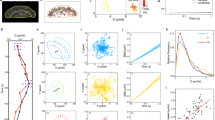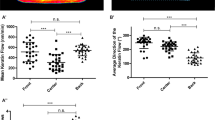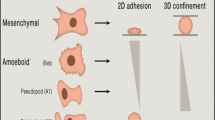Abstract
Keratocytes derived from the epidermis of aquatic vertebrates are now widely used for investigation of the mechanism of cell locomotion. One of the main topics under discussion is the question of driving force development and concomitantly subcellular force distribution. Do cells move by actin polymerization-driven extension of the lamella, or is the lamella edge extended at regions of weakness by a flow of cytoplasm generated by hydrostatic pressure? Thus, elasticity changes were followed and the stiffness of the leading front of the lamella was manipulated by local application of phalloidin and cytochalasin D (CD). In scanning acoustic microscopy (SAM), elasticity is revealed from the propagation velocity of longitudinal sound waves (1 GHz). The lateral resolution of SAM is in the micrometer range. Using this method, subcellular tension fields with different stiffnesses (elasticity) can be determined. A typical pattern of subcellular stiffness distribution is related to the direction of migration. Cells forced to change their direction of movement by exposure to DC electric fields of varying polarity alter their pattern of subcellular stiffness in relationship to the new direction. The cells spread into the direction of low stiffness and retract at zones of high stiffness. The pattern of subcellular stiffness distribution reveals force distribution in migrating cells; i.e., if a cell moves exactly in a direction perpendicular to its long axis, then the contractile forces are largest along the long axis and decrease toward the short axis. Locomotion in any angle oblique to this axis requires an asymmetric stiffness distribution. Inhibition of actomyosin contractions by La3+ (2 mM), which inhibits Ca2+ influx, reduces cytoplasmic stiffness accompanied by an immediate cessation of locomotion and a change of cell shape.
Local release of CD in front of a progressing lamella activates a cell to follow the CD gradient: The lamella thickens locally and is extended toward the tip of the microcapillary. Release of phalloidin stops extension of the lamella, and the cell turns away from the releasing microcapillary. The response to CD is assumed to be the result of local weakening of the cytoplasm due to severing of the actin fibrils. Phalloidin is supposed to stabilize the leading front by inhibition of F-actin depolymerization.
These observations are in favor of the assumption that migration is due to an extension of the cell into the direction of minimum stiffness, and they are consistent with the hypothesis that local release of hydrostatic pressure provides the driving force for the flux of cytoplasm.
Similar content being viewed by others
References
Goodrich, H. B. (1924) Cell behavior in tissue cultures.Biol. Bull. (Woods Hole) 46, 252–262.
Bereiter-Hahn, J. (1967) Dissoziation und Reaggregation von Epidermiszellen der Larven von Xenopus laevis (Daudin) in vitro.Z. Zellforsch. 79, 118–156.
Bereiter-Hahn, J., Strohmeier, R., Kunzenbacher, I., Beck, K., and Vöth, M. (1981) Locomotion of Xenopus epidermis cell in primary culture.J. Cell Sci. 52, 289–311.
Strohmeier, R. and Bereiter-Hahn, J. (1987) Hydrostatic pressure in epidermal cells is dependent on Ca-mediatied contractions.J. Cell Sci. 88, 631–640.
Bereiter-Hahn, J. and Strohmeier, R. (1987) Biophysical aspects of motive force generation in tissue culture cells and protozoa.Fortschr. Zool. 34, 1–15.
Strohmeier, R. and Bereiter-Hahn (1984) Control of cell shape and locomotion by external calcium.J. Exp. Cell Res. 154, 412–420.
Mittal, A. K. and Bereiter-Hahn, J. (1985) Ionic control of locomotion and shape of epithelial cells: I. Role of calcium influx.Cell Motil. 5, 123–136.
Theriot, J. A. and Mitchison, T. J. (1991) Actin microfilament dynamics inlocomoting cells.Nature 362, 167–171.
Anderson, K. I., Wang, Y. L., and Small, J. V. (1996) Coordination of protusion and translocation of the keratocyte involves rolling of the cell body.J. Cell Biol. 134, 1209–1218.
Lasa, I. and Cossart, P. (1996) Actin-based bacterial motility: towards a definition of the minimal requirements.Trends Cell Biol. 6, 109–114.
Hildebrand, J. A. and Rugar, D. (1984) Measurement of cellular elastic properties by acoustic microscopy.J. Microsc. 134, 245–260.
Bereiter-Hahn, J. (1995) Probing biological cells and tissues with acoustic microscopy, inAdvances in Acoustic Microscopy (Briggs, A., ed.), Plenum, New York, pp. 79–115.
Nieuwkoop, P. D. and Faber, J. (1956)Normal Table of Xenopus laevis (DAUDIN). North Holland, Amsterdam
Strohmeier, R. and Bereiter-Hahn, J. (1991) Emigration of bilayered epidermal cell sheets from tadpole tails (Xenopus laevis).Cell Tissue Res. 266, 615–621.
Litniewski, J. and Bereiter-Hahn, J. (1990)J. Microsc. 158, 95–107.
Dembo, M. (1994)Biomechanics of Active Movement and Division of Cells, NATO ASISeries, vol.H 84. (Akkas, N., ed.), Springer, Berlin.
Lüers, H., Hillmann, K., Litniewski, J., and Bereiter-Hahn, J. (1992)Cell Biophys. 18, 279–214.
Bereiter-Hahn, J. and Lüers, H. (1994) The role of elasticity in the motile behaviour of cells, inBiomechanics of Active Movement and Division of Cells, NATO ASISeries, vol.H 84 (Akkas, N., ed.), Springer, Berlin, pp. 181–230.
Cooper, M. S. and Schliwa, M. (1985) Electrical and ionic controls of tissue cell locomotion in DC electric fields.J. Neurosci. Res. 13, 223–244.
Cooper, M. S. and Schliwa, M. (1986) Motility of cultured fisg epidermal cells in the pressure and absence of direct current electric fields.J Cell Biol. 102, 1384–1399.
Ploem, J. S. (1975) Reflection-contrast microscopy as a tool for investigation of the attachment of living cells, inMononuclear Phagocytes in Immunity, Infection and Pathology. (Furth, R. V., ed.), Blackwell, Oxford, pp. 405–421.
Beck, K. and Bereiter-Hahn, J. (1981) Evaluation of reflection interference contrast microscope images of living cells.Microsc. Acta 81, 153–178.
Bereiter-Hahn, J. and Vesely, P. (1994) Reflection interference microscopy, inMethods in Cell Biology, vol. 2 (Celis, J. E., ed.), Academic, London, pp. 15–25.
Fiskum, G. (1985) Intracellular levels and distribution of Ca2+ in digitonin-permeabilized cells.Cell Calcium 6, 25–37.
Faulstich, H., Trischmann, H., and Mayer, D. (1983) Preparation of tetramethylrhodaminyl-phalloidin and uptake of the toxin into shortterm cultured hepatocytes by endocytosis.Exp. Cell Res. 144, 73–82.
Langer, G. A. and Frank, J. S. (1972) Lanthanum in heart cell culture. Effect on calcium exchange correlated with its localization.J. Cell Biol. 54, 441–455.
Bereiter-Hahn, J. (1987) Scanning acoustic microscopy visualized cytomechanical responses to cytochalasin D.J. Microsc. (Oxford) 146, 29–39.
Tillmann, U. and Bereiter-Hahn, J. (1986) Relation of actin fibrils to energy metabolism of endothelial cells.Cell Tissue Res. 243, 579–585.
Harris, A. K., Wild, P., and Stopak, D. (1980) Silicone rubber-substrata: a neww wrinkle in the study of cell locomotion.Science 208, 177–179.
Harris, A. K., Stopak, D., and Wild, P. (1981) Fibroblast tration as a mechanism for collagen morphogenesis.Nature 290, 249–251.
Lee, J., Leonard, M., Oliver, T., Ishihara, A., and Jacobson, K. J. (1994) Traction forces generated by locomotin keratinocytes.Cell Biol. 127, 1957–1964.
Oliver, T., Dembo, M., and Jacobson, K. (1995) Traction forces in locomotion cells.Cell Motil. Cytoskel. 31, 225–240.
Cooper, J. A. (1987) Effects of cytochalasin and phalloidin.J. Cell Biol. 105, 1473–1478.
Petersen, N. O., McConnaughey, W. B., and Elson, E. L. (1982) Dependence of locally measured cellular deformability on position on the cell, temperature, and cytochalasin B.Proc. Natl. Acad. Sci. USA 79, 5327–5331.
Faulstich, H., Schafer, A. J., and Weckauf, M. (1977) The dissociation of the phalloidin-actin complex.Hoppe-Seyler's Z. Physiol. Chem. 358, 181–184.
Coluccio, L. M. and Tilney, L. G. (1984) Phalloidin enhances actin assembly by preventing monomer dissociation.J. Cell Biol. 99, 529–535.
Wehland, J., Osborn, M., and Weber, K. (1977) Phalloidin-induced actin polymerization in the cytoplasm of culture cells interfers with cell locomotion and growth.Proc. Natl. Acad. Sci. USA 74, 5613–5617.
Wohlfahrt-Bottermann, K. E. (1979) Contraction phenomena in Physarum: new results.Acta Protozool. 18, 59–73.
Yanai, M., Kenyon, C. M., Butler, J. P., Macklem, P. T., and Kelly, S. M. (1996) Introcellular pressure is a motive force for cell motion in amoeba proteus.Cell Motil. Cytoskel. 33, 22–29.
Author information
Authors and Affiliations
Corresponding author
Rights and permissions
About this article
Cite this article
Bereiter-Hahn, J., Lüers, H. Subcellular tension fields and mechanical resistance of the lamella front related to the direction of locomotion. Cell Biochem Biophys 29, 243–262 (1998). https://doi.org/10.1007/BF02737897
Issue Date:
DOI: https://doi.org/10.1007/BF02737897




